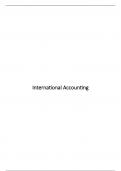Resume
Complete summary International Accounting (2023/2024) (17/20)
- Établissement
- Katholieke Universiteit Leuven (KU Leuven)
This is a complete summary that I used for the open book exam of the course “D0R50a: International Accounting” given in the year 2023/2024. This is a summary based on: all the slides (including notes), book, online multiple choice questions & open questions from the book. This course is g...
[Montrer plus]



